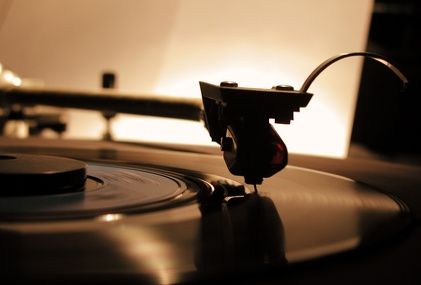Best Album Covers: Eldorado

This is the next entry in Best Album Covers, a series begun right here. The first successful long-playing microgroove record for the phonograph was introduced by Columbia Records back in June of 1948. Yet, album covers (the paper board packaging that held them) didn’t come into their own graphically till decades later. Eventually becoming the cultural stamp on the music of the time. Catching the eyes of potential record-buyers and later their ears and minds. Melding the musical experience with the artist into a unique visual form.
Why Compact Disc versions of album art don’t exactly raise the same reaction these days was looked at in this post. Although, music label artistry continues to be noticed and discussed among the material published today. The bits and bytes are looking over their shoulder, though, because vinyl hasn’t entirely gone the way of the dinosaur. Online or at the record shops still out there. Cover art hasn’t lost purpose, either for old and new. Mostly, it’s my contention while digital reigns supreme, its vigor among fans lacks the tactile passion of the past LPs.
Hence the reason for this series. Some register more with me musically than others, though. Yet, the artwork will always take center stage, at least here. Let’s continue shall we?

Bruce Eder writing for Allmusic described the work of those “Searching for her silver light…”:
“Eldorado was strongly reminiscent in some ways of Sgt. Pepper’s Lonely Hearts Club Band. Not that it could ever have the same impact or be as distinctive, but it had its feet planted in so many richly melodic and varied musical traditions, yet made it all work in a rock context, that it did recall the Beatles classic. It was a very romantic work, especially on the opening “Eldorado Overture,” which was steeped in a wistful 1920s/1930s notion of popular fantasy (embodied in movies and novels like James Hilton’s Lost Horizon and Somerset Maugham’s The Razor’s Edge) about disillusioned seekers.”
The Electric Light Orchestra was unique in that they harkened back to The Lads and the 60s, but stayed true to the British rock of the 70s. The band from Birmingham, England a bigger hit here in the U.S. than in its native UK. Their fourth album, about the thoughts, images, and sensations that distract during daylight or occur in sleep, stuck in listeners’ heads in more ways than one.
When Sharon Osbourne (yeah, Ozzy’s spouse) first showed her cover design to the band she managed, they thought it crap. They relented when she explained it came from the classic film that paralleled their album’s theme. In the 100 Best Photo Album Cover article by Popular Photography Magazine, writer D.S. explained why a still frame of an American musical fantasy conveyed this so well:
“And what is the most famous dream of all? That’s right — the one Dorothy had about Oz, witches, and ruby slippers. The album’s cover featured a pivotal still from the 1939 film.”
ELO’s first concept album, The Wizard of Oz image instantly recognizable by young and old upon release. The key moment of the film, one frozen on the psyches of movie-goers, young Dorothy’s ownership of the enchanted slippers never more clear as the villainous old crone greedily wishing to possess them was manifestly spurned. The image electrifyingly etched for viewers of the film and album.
Artist: Electric Light Orchestra
Title: Eldorado
Date: 1974
Label: Jet (UK), United Artists (US)
Track Listing (and yes, turn that record over):
Side one
- “Eldorado Overture”
- “Can’t Get It Out of My Head”
- “Boy Blue”
- “Laredo Tornado”
- “Poor Boy (The Greenwood)”
Side two
- “Mister Kingdom”
- “Nobody’s Child”
- “Illusions in G Major”
- “Eldorado”
- “Eldorado Finale”
The entire series can be found here.


6 Responses to “Best Album Covers: Eldorado”
I love ELO.
#2 Side One is my favorite.
LikeLike
It must be said that employing violinists for their concerts was genius. Thanks, Cindy. 🙂
LikeLike
That is an awesome album cover indeed! I’m not familiar w/ their music though, but now I know who they are, thanks Michael 😀
LikeLiked by 1 person
[…] As mentioned, Electric Light Orchestra was unique in that they harkened back to The Lads and the ’60s, but stayed true to the British rock of the ’70s. Even in the midst of a temporary pullback from pop music during my Jazz Fusion period, given the radio play this album generated1 with its handful of art-rock singles, just couldn’t avoid this double-LP. Even if I had wanted to. […]
LikeLike
I was the designer of that album cover, and the folks at United Artists really wanted to break this band. So after the rather sedate, b&w On The Third Day cover, we wanted something with real impact. Since the parallels to Dorothy’s search for her own Eldorado were obvious, we built our own “Emerald City” out of plexiglass blocks and took it out to the desert to shoot at sunrise. Unfortunately it was a windswept day and the photos looked like sand on plastic. So back to the drawing board. I knew about a shop in Hollywood that had boxes of classic films cut up into slides. I found the Dorothy’s shoes image, reversed it for more impact, and even though the band didn’t like it much at first, I think they came around in the end, especially when they started getting noticed. It also appeared on a giant billboard on the Sunset Strip, which turned some heads.
LikeLiked by 1 person
Thank you for the background information as it adds so very much to the story behind the scenes. It’s a fantastic LP cover for one of the great bands of the era. And I’m pretty sure I saw its billboard on Sunset Blvd one day when I made a pilgrimage to Tower Records back then. 🙂
LikeLike